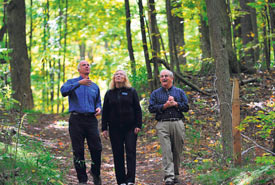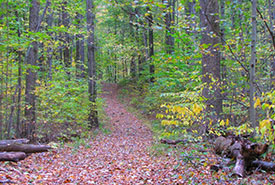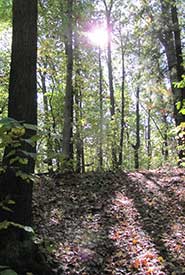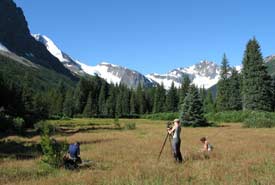Leaving a lasting legacy with conservation

Paul Smith (right) takes a walk through the forest he transferred to NCC, with Karen Clarke-Whistler, chief environment officer of TD Bank Group, and John Lounds, NCC president and CEO (Photo by Simon Wilson)Paul
When Paul Smith was a child, he called the family’s forest, located three to four miles from his home, “Grandma’s Woods.” Deeded to his ancestors in 1856, it had passed to his grandmother, and he remembers that she had just lost a barn and needed to build a new one.
The forest served as a source of timber to build the new barn. It also provided the family with something sweet: maple syrup. “Every spring, our whole family would go out and tap some of these beautiful trees,” recalls Mr. Smith. “Our ancestors made maple syrup for over 200 years, and we’d make it the traditional way by using buckets, just like they did.”
Through the generations, the family felt it was important to take just what they needed, both in maple syrup and trees, which were cut only for building or repairing the houses or barns on the farm, says Mr. Smith. As a result, the forest is an oasis of older growth in a landscape that has lost much of its original forest cover.
It wasn’t an easy decision to pass this special place along, says Mr. Smith, who transferred 43 acres (17.4 hectares) of the forest to the Nature Conservancy of Canada (NCC) in 2012. It was the first property acquired through a collaboration with TD Bank Group under the TD Forests program. Located north of Port Rowan, Ontario, the forest is now integrated into Backus Woods, which is part of the 1,847 acres (747.5 hectares) that NCC has helped conserve in the heart of the Carolinian forest region.

Backus Woods (Photo by NCC)
While the Carolinian forest region covers less than one per cent of the land mass in Canada, it boasts the greatest biodiversity of any region in the country. And it is also home to hundreds of rare plant and animal species that are considered at risk, says Dan Kraus, Weston conservation scientist with NCC, who calls Backus Woods “the best example of old growth in southern Ontario.”
It is a perfect example of the type of forest that TD Forests aims to protect. “We are focusing largely on southern Canada. This is where most Canadians live, which creates more pressure on forests,” says Mr. Kraus, adding that a progressively more fragmented landscape increases the need for wildlife corridors and linkages to other habitat.

Backus Woods, Norfolk, Ontario (Photo by NCC).
Wood ducks, screech owls, woodpeckers and flying squirrels are among the forest dwellers that nest in the cavities of big trees, which often can’t be found in younger forests.
All this is taken into account when NCC identifies priority areas for action, says Mr. Kraus. In the last five years, more than 40,000 acres (16,000 hectares) of important forested habitats across Canada have been protected by NCC thanks to support from TD Forests. “When you look at forest conservation in the past, no one regrets that this was done,” he adds. “I believe that this is the same for the forests we are protecting today — they will be appreciated by future generations even more than we can
imagine now.”
Mr. Smith also believes protecting his treasured “Grandma’s Woods” was the right thing to do. “We did some soul-searching about what to do with the land but eventually came to the conclusion that if we wanted to preserve it in its pristine state, it would be best to go with NCC,” he explains. “Now, there is a posted trail and more people can enjoy the forest.”
And every spring, Mr. Smith, his wife, children and grandchildren still venture into the forest. “It was part of our agreement with NCC that we could continue to make a small amount of maple syrup.”
The family keeps warm at the sugar shanty, which Mr. Smith, a retired architect, has constructed with the wood from torn-down barns from the farm. “The big barn beams were probably cut from the forest and now the timber has gone back there,” he adds.
This post originally appeared in the Globe and Mail and was produced with the support of Randall Anthony Communications Inc.


